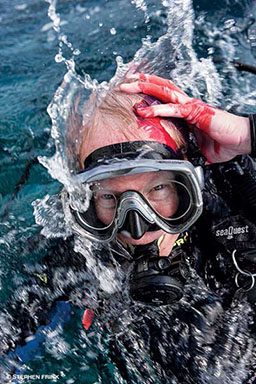Scuba divers often find themselves sharing the water with boats, as divers use boats to travel to dive sites and sometimes dive in areas with heavy boat traffic. Collision injuries from vessels and propeller strikes are hazardous for divers in such areas.
The U.S. Coast Guard Boating Safety Resource Center reports that from 2005 to 2013 boat-propeller strikes caused 636 injuries and 38 deaths of people engaged in water activities (boating, water skiing, swimming, snorkeling, diving, tubing, etc.); 442 of these injuries and 29 of these deaths were caused by a person being struck by a vessel. Preventing accidents while diving in areas with boat traffic requires that divers be aware of vessels at all times both below the surface and topside.
Depending on the location and vessel type, licensure or certification through boat-safety education courses may be required. Boating laws vary internationally and by state in the U.S.; therefore, it is important that both boat operators and divers remain aware of the regulations in effect for a specific location.
Signaling Tools
Dive flags. Flying a dive flag is an effective and in some places required means of alerting boats that divers are in the water. Similar to boat-operation laws, dive-flag regulations vary by location and vessel type in the U.S. and internationally. The two types of flags most commonly recognized in relation to diving are the alpha flag and the diver-down flag.
The internationally recognized alpha flag is flown when the mobility of any vessel is restricted, indicating that other vessels should yield the right of way. This flag is often flown along with the diver-down flag when divers are in the water, because dive boats must maintain a close vicinity to the divers and cannot quickly move. The diver-down flag explicitly signals that a diver is in the water, and it should always be flown from a vessel that has divers in the water. The alpha flag indicates that divers are in the area; however, it also has other uses. It is best practice to fly the diver-down flag along with the alpha flag to avoid miscommunication.

A diver-down flag is recommended to alert vessels during shore diving. The distance divers are required to stay within the dive flag depends on the dive location. A floating buoy tethered to a dive reel can be used to signal where divers are located in the water. A reel towing a floating dive flag should never be attached directly to the diver. Carrying the reel helps prevent the diver from being dragged in case the flag is caught by a passing boat.
Whether the dive flag is flown on a boat or a buoy marker, the flag should be in good condition to ensure visibility. Replace the flag when the safety integrity is compromised by faded color or rips. The size of the required dive flag may also vary by location. Always make sure the flag is visible from all directions.
Surface markers. Safety tools such as surface marker buoy (SMBs), whistles and other audible signals, dive lights and signaling mirrors can be used to communicate your location to boaters after you ascend from a dive. An SMB may be used in addition to a dive flag for alerting boaters that divers are in the water. Before the dive, review how to deploy the SMB to be prepared for using it on ascent.
When using signaling devices at the surface, divers should never assume they are visible to boat operators. Glare from the sun, waves, passengers, weather conditions and other factors can make noticing a diver in the water difficult.
Be Attentive Underwater
In addition to using signaling devices and paying attention to boat traffic topside, divers must be aware of passing boats when they are underwater. Looking and listening for boats overhead is a good practice, but keep in mind that poor visibility and sound localization when underwater can interfere. In most cases, a diver should be able to hear a boat from underwater, but it may be difficult to localize the direction from which the sound is coming because sound travels approximately four times faster in water than in air. Wearing a hood may alter hearing thresholds even more.
A safety stop for three minutes at 15 feet (5 meters) allows a diver to decrease nitrogen uptake and is also an opportunity to scan for boat traffic before ascending to the surface. Divers should be careful not to rely on quick reaction time in the event that they must move away from a passing boat while underwater. A boat can rapidly close on an unknowing diver without always granting enough time to move a safe distance away. For these reasons it is not advisable for divers to rely on observing for boats under the surface without a surface signaling device.
Have an Action Plan
A plan for treatment and evacuation of a diver struck by a boat or propeller should be in place before arrival at the dive site. To treat a laceration wound, stem the loss of blood by applying pressure bandages, and get the injured person to medical services as quickly as possible. Know who to call and what role others play in responding to a medical emergency.
Research & Prevention
DAN Europe currently has a propeller-injury campaign to educate boat operators and divers how to safely share dive sites; visit www.daneurope.org/propeller-injuries. The website provides a collection of incidents and witness accounts as well as posters and educational materials so that divers can learn to prevent future incidents.
In North America, DAN utilizes an online incident-reporting system to collect information on dive accidents and injuries, including propeller and other boat-collision incidents; visit Research.net/r/DAN-DIRS. The information on reported cases is used for case summaries and to create prevention materials.
© Alert Diver — Q4 Fall 2014